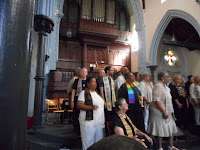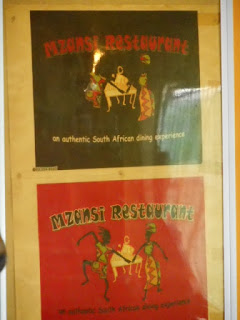Cape Town
Capetown, the place of sweet waters, is thought to have been founded by a Dutch commander for the Dutch East India Company, but some dispute this with the claim that the indigenous people already on the land were the Camissa. The Dutch East India company settled here because of the 4 major rivers. Cape Town is the halfway point between Asia and Europe. The company traded in spices, silk and the slave trade. Slaves though were from Malaysia, east Africa, west Africa and India. The Dutch tried to enslave the locals but they refused to be enslaved and fought back. The slaves procreating by choice or by force were what created the coloreds in the area. While the Dutch planned the city, it was the slaves that actually built it. Slaves with marketable skills could fetch higher prices at the market because they could be rented out by the masters.
The Malay houses were originally the slave quarters. houses during the time of slavery were painted different colors based on the occupation of the resident, doctors house may for example be painted blue. The Khoikhoi people indigenous to the area speaking a clicking language that they are currently in the process of trying to revive.
Table Mountain
I know, I know cheesy but our bus driver for the next few days really is named Moses. And we went to the top of
Table Mountain today. To date more than 26 millions people have visited this wonder.Table mountain is 1086m at its highest point, Maclear's Beacon. Table mountain is considered to be one of the New 7 Wonders of Nature .Some of the peaks of the mountain include lion's head, the 12 apostle's, devil's peak.Local lore about devil's peak in the mountain:
A Dutch pirate with a wooden leg named VanHunks was exiled outside when his wife told him that he could not smoke in the house. He sat on the mountain puffing away when he was suddenly approached by a man who challenged him to see who could blow more smoke. The stranger lost the challenge and as he was walking away Van Hunks noticed the horns and realized he had just beaten the devil. Hence the name devil's peak.
The cable car transporting us up to the top of the mountain has a 65 person capacity meaning that 800 people are potentially transported in an hour. Rode up a funicular with a rotating floor that allows you to see 360 degrees as you ascend to the plateau of the mountain. The moving floor is initially disorienting but offers a great view of the water and the mountain. The only cable cars are only allowed to travel at a maximum speed of 10 meters per second.
Responsible tourism
Responsible tourism is defined as making better places for people to live and better places for people to visit. This involves a collaboration between tour operators, governments, hoteliers, local people, and tourists make tourism sustainable. Our excursions today after Table Mountain involved a group named
Coffee bean routes. We were split into three groups midday in order to visit the Dompas Museum and to explore the history of Langa township.We traveled to the Dompas Museum in Langa township, had lunch at a local restaurant, attended a presentation with a local entrepreneur, and ended the afternoon with a concert by the Zamanani brothers.
Langa Township
Langa is named for Chief Langalibalele, whose name means the sun is scorching hot. The chief was imprisoned on Robbens Island for resisting the Natal government. Langa is the first black planned township in South Africa.
Dompas Museum
 |
| Actual Dompas book |
Our host at the museum has lived through an experience during Apartheid that for most of us would lead to hatred, resentment, anger, and a whole host of other unhealthy emotions. He was shot by the police and then jailed instead of being treated when he went to the hospital for treatment. The doctor instead of treating him called the police and accused him of bleeding on the floor. He was not operated on for more than a week after being shot. He visited three hospitals during this time and was only treated by medical professionals as two of the three medical facilities. He has since sued the city and won. He chose not to hate White people as a result of his connection with and understanding of Nelson Mandela's stance after being unjust imprisoned for more than two decades.
No one is born hating another person because of the color of his skin or his background or his religion. People must learn to hate, and if they can learn to hate, they can be taught to love, for love comes more naturally to the human heart than its opposite." -Nelson Mandela
The museum is meant to be a history of the dompas passes and the people who were forced to pass through this edifice when it was active. The museum is situated in what used to be the government office where blacks would have to come and get a pass for living in the community. Men would get off the train station and must be immediately vaccinated. Vaccination at the time was done one of two ways both of which required being stripped naked and being dipped like animals before being given your clothing back. The methods were
- you walked naked through water that had chemicals in it as a means of vaccination, or
- you were sprinkled with a power.
Blacks were forced to carry pass books like the one above. The name was later changed to reference book but the intention of the booklet did not change. Pass laws were rescinded in 1986. In 1955 there was a women's anti pass campaign.
The pass book contained your picture, your name, social security number, tribe name, employment verification, and pass board stamp. Each month your employer would have to sign the book indicating that you were still employed there and every three months or so you would be required to go before the judge to get the permit renewed for you to stay. Police officers had the right to demand the pass at anytime. If you were caught without the pass book you could be immediately arrested and brought before the judge. If no one in the audience was a friend or family member of yours then your family might not find out that you had been arrested until you were released months later. Everyone who came before the judge for a missing pass book was guilty and if you replied otherwise you might get three months in jail to think about your answer. In the "court room" was the white judge, the colored clerk, and the spectators.
Between 500-800 people were serviced in this building each day including Sundays. If the judge thought that you were intelligent or you responded as if you had more than a thimble's worth of sense your sentence would be harsher and you might spend 3 months in jail. This resulted in many blacks dumbing themselves down in order to survive. Police were often found bribing people by ordering them to " buy me a drink" and then surreptitiously taking the money for the drink for ignoring the lack of a pass. IT was hard during this talk not to draw parallels to the US Jim Crow South.
Social Enterprise Development
Tony's desire is to create a Langa Quarter similar to the French Quarter in New Orleans. He did a presentation on social enterprise development which entails social inclusion through social enterprise. Social inclusion involves the three P's: people planet, and profit. You are with this model ultimately trying to create a cleaner safer, greener method of existing by creating jobs and opportunities. Where the center is situated is the white area of Pinelands, the colored area of Athlone and the black area of Langa. The areas all sit next to each other but do not cross mingle creating a widening class divide.
WonderBags
Mzansi Restaurant
Lunch today was at
Mzansi Restaurant. The bookings only restaurant is situated in Langa Township and is a tourist attraction meant to teach tourists about African food in a traditional African environment. The entertainment was provided by a live band. The owners children also provided a beautiful rendetion of American pop culture hits and a traditional song.
Guga S'thebe visitors Center
In addition to the outdoor amphitheater this visitor's center also has a host of artisans displaying their work . Everything from ceramics and glass art to small souvenir type trinkets. There are workshops held here and we even got to meet a ceramics artist with a kiln on site for firing.
Zamanani Brothers

The Zamanani Brothers are an all male a cappella group. The group performed in the outdoor amphitheater of the Guga S'thebe visitors center. The heartily welcomed us in song followed by a learning experience in which we sang in conjunction with them a song that they taught us. We then sang one of the signature songs we learned for this tour, Thula Sizwe, singing together in harmony our African brothers and our American choirs was a beautiful sound to behold.
Dinner and cultural music exchange
Without visitors your house is not a home.~Unknown No truer words were ever spoken than these when we prepared for our evening adventure.

Our entertainment and meal for the night was provided by the family of Wesley Valentine. Valentine is a 25 year old bass player. He is plays the guitar as well but as this is a very popular instrument he learned to play bass and piano. His mother cooked us a delicious African meal and invited our group of 14 into her home for a mini concert by her son and a musician friend of his who plays the saxophone.


After leaving the Valentine home we were treated to our second mini concert featuring a marimba and a djembe. Those of us at this that were part of this group danced with our hosts and enjoyed music in English and their home language. We participated in a sing along of His Eye is on the Sparrow which our host also sang in his home language after we had all done the song in English. I have personally decided that I don't like ginger beer. One of our hosts provided it as refreshment which I know is neither here nor there. The nightly entertainment was awesome. Each of our three groups visited a different site so I do not have a clear point of reference for what instrumental experience the others had. I have been told that the experience was eye opening for all.
Cape Town photos
 On our last day here in Cape Town our only engagement was a service at the Central Methodist Church in Cape Town. They chose to make their Sunday morning service our ministry. Despite the lack of electricity, it went out about ten minutes into rehearsal, we were able to share as only we can the message of God's love and peace. It has been a whirlwind journey but definitely one that we as individuals or as collective groups will never forget.
On our last day here in Cape Town our only engagement was a service at the Central Methodist Church in Cape Town. They chose to make their Sunday morning service our ministry. Despite the lack of electricity, it went out about ten minutes into rehearsal, we were able to share as only we can the message of God's love and peace. It has been a whirlwind journey but definitely one that we as individuals or as collective groups will never forget.










































